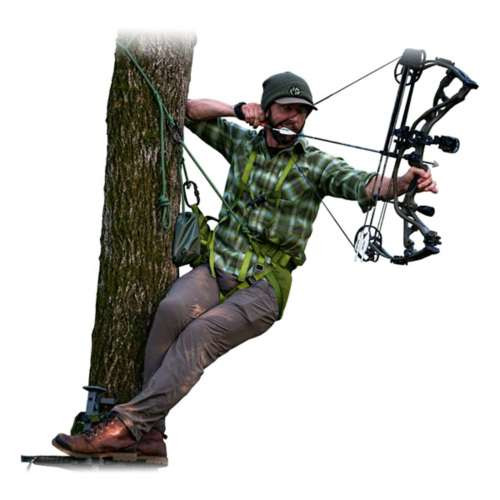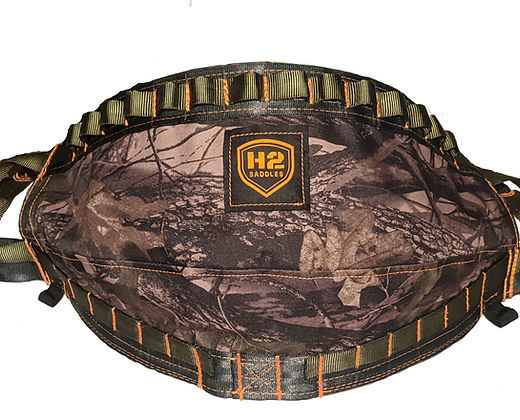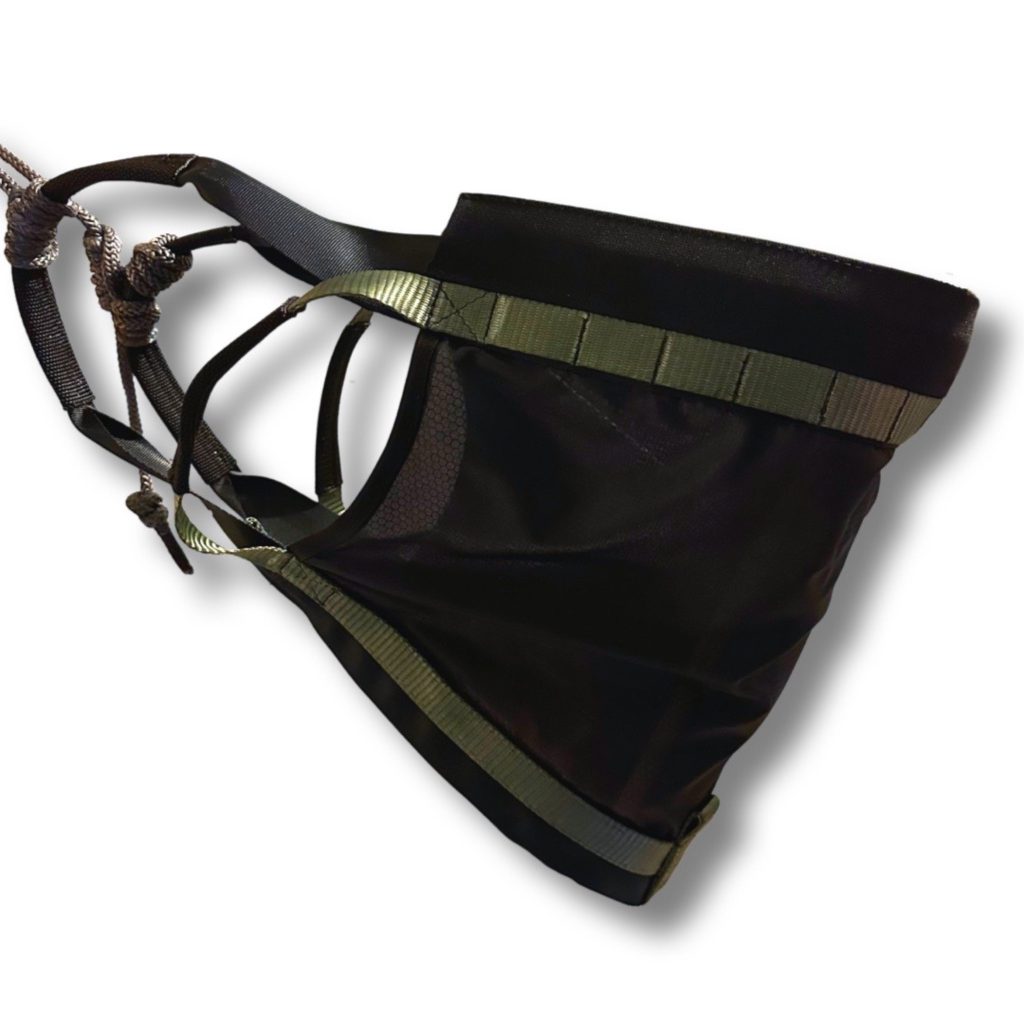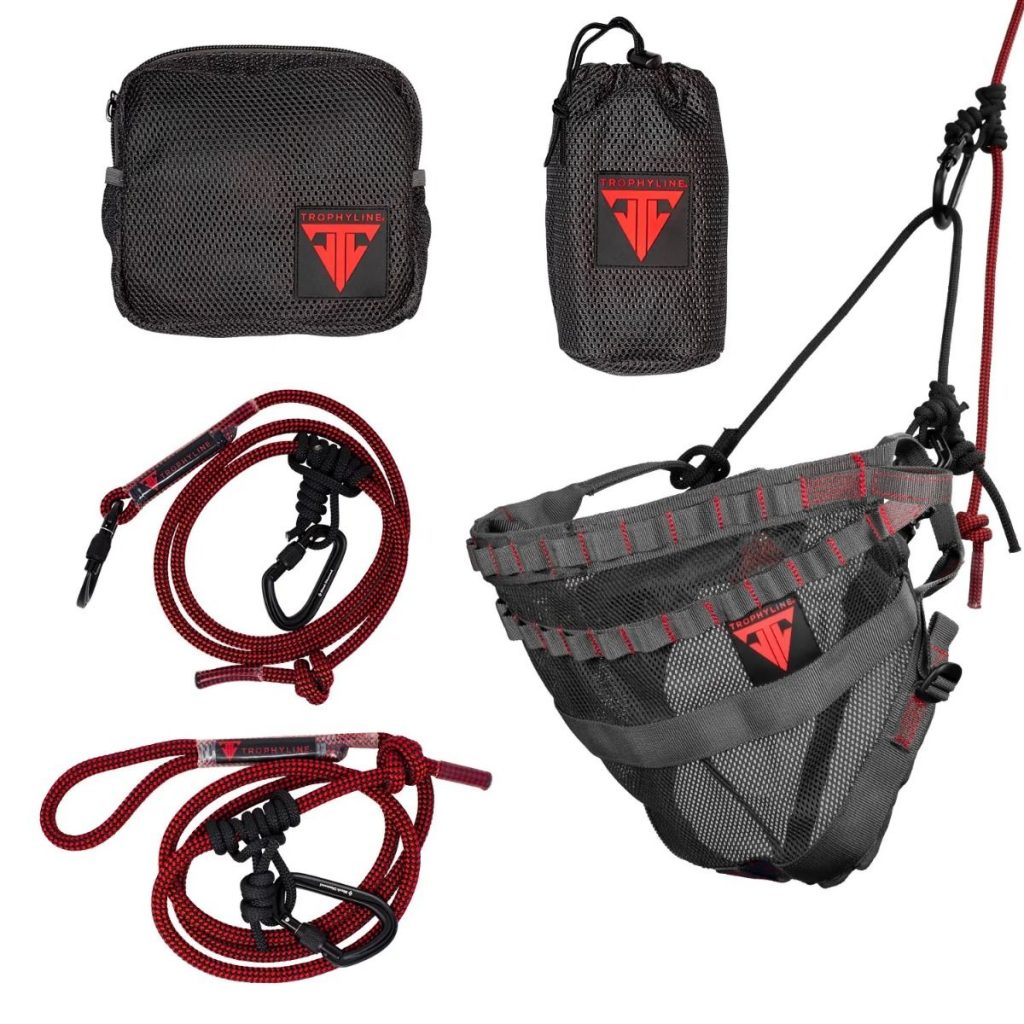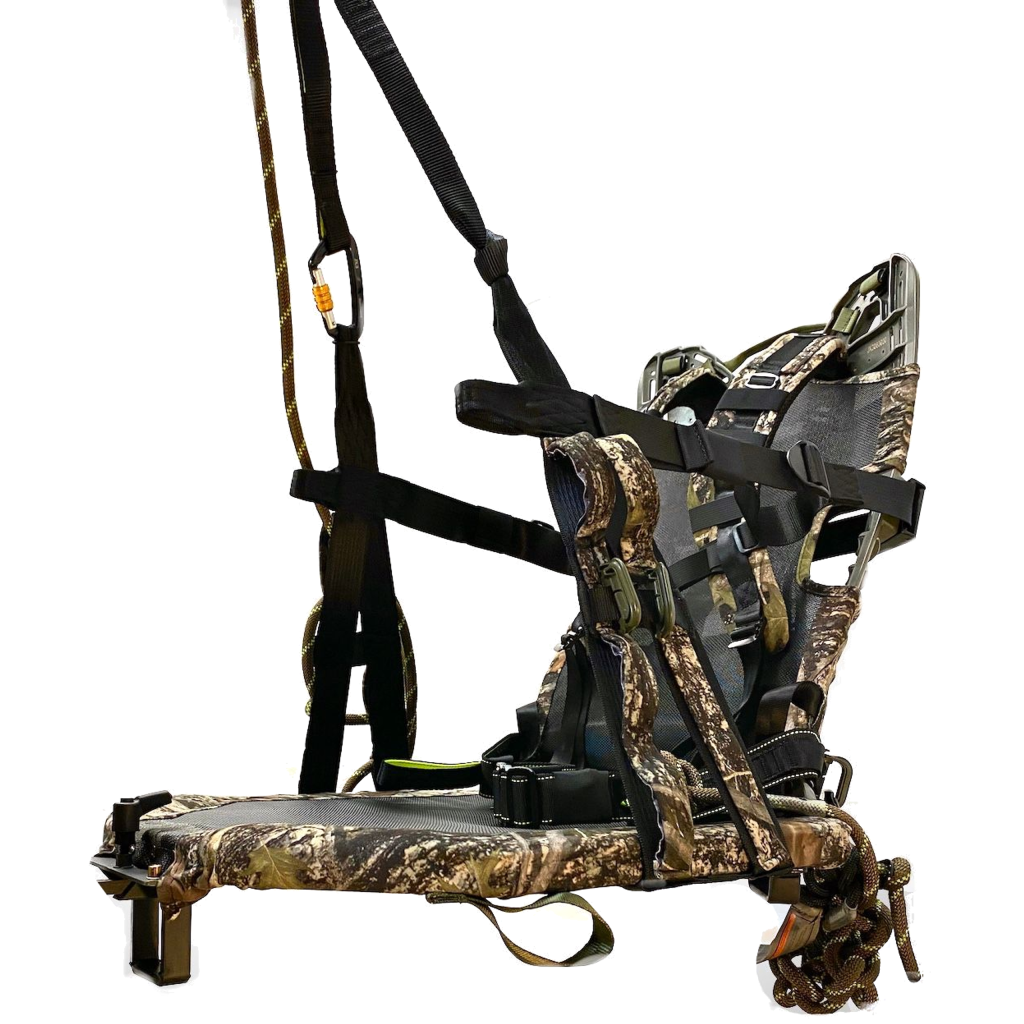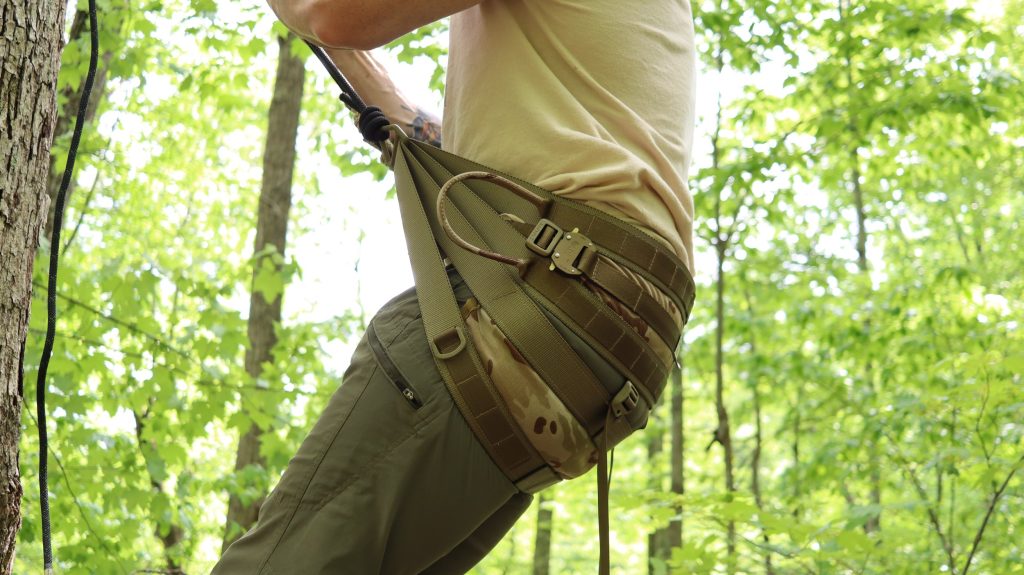This fall is the 7th season I’ve been hunting whitetail with the aid of a tree saddle. A lot has changed in that period of time, both for me personally and for the tight-knit community that sprang up around saddles. What used to be a somewhat eccentric and offbeat tribe of like-minded mobile hunters huddled around the virtual campfire of saddlehunter.com (which, I’m somewhat proud to say, I found just before it became cool) has grown into a subset of deer hunting that is drawing attention from some of the biggest names in the industry. Once figures like The Hunting Public and Levi Morgan are sitting in the same stand as you, you’ve definitely gone mainstream!
In this article, we’ll go over some top picks for tree saddles, and interview Dan Osterhaut of Eastern Woods Outdoors to pick his brain on the most important criteria to consider when choosing the best tree saddle for you.
Best Budget Tree Saddle
Features
- Rated up to 350lb
- Comfortable shoulder straps
- Cool mesh seat
- Tow rope anchor system
- Ultra grip traction
- In-platform quick clip anchor mounts
The XOP Regegade comes in at under $200, which is impressive considering it also comes with your linemans’ belt, tether, and carabiners. Plus, it can double as a conventional full-body safety harness, making it a steal of a deal for the budget-minded hunter.
Best Tree Saddle For Big Guys (or Little Guys)
Features
- 6000lbs rated webbing
- 4000 bs rated climbing tubular webbing for linesman loops
- Adjustable bridge
- Reinforced bridge loops
- Molle attachment loops
- Heavy Duty Riggers belt/buckle
- Cordura Fabric Seat
- Leg loops of 1000 lb rated webbing with G-hooks for quick attachment.
H2 saddles come in 5 different sizes, offering more variation than is typically seen on the market. They’ve got you covered from a size 28” waist all the way up to a 45” waist.
If that doesn’t cover you, read more below about the custom saddles offered by small manufacturers such as TX5, Overwatch Outdoors, CGM, and others.
Best Tree Saddle for Beginners
Best Tree Saddle For Beginners
Features
- Metal-free
- Weighs right around 1 lb
- Can be stuffed into a pocket on your backpack
- Built with high-quality hex ripstop material that’s rated for 400 lbs
- Improved bridge loop webbing, allowing for greater adjustability
- Industry first saddle with an amsteel belt
The Agile is Dan’s personal recommendation for a beginner’s saddle. Its simple one-panel design makes it a lightweight and comfortable all-around performer.
Best Tree Saddle Bow Hunting
Features
- 300 lb load rating/weight rating
- Adjustable waist buckle
- Adjustable leg straps
- 33” Adjustable 3/8” Rope bridge
- Comes with Prusik and Black Diamond Carabine
- Separate Lineman Loops
- Two rows of Molle attachment system
Trophyline is a very well established name in the saddle hunting industry. They build a solid saddle, and the lightweight and cool mesh design of the covert-lite is perfect for warm, early-season bow hunts.
Best Tree Saddle For Gun Hunting
Features
- 300 lb load rating/weight rating
- All safety components tested and meet or exceed industry standards
- Sewn loop lineman, tether, and prusik ropes
- Contoured EVA foam shoulder straps
- Cobra style metal buckles
- Molle gear loops on the waist belt, main harness, and shoulder straps
- Built-in ground chair feature
- Built-in pack frame harness with adjustable clamps
- Back adjustment belt adjusts the angle of the back support
- Adjustable standoff tree fork with 1 – 7 inches of adjustments
- Built-in bow holder
For all-day “rutcation” stakeouts, nothing beats the JX3. Yes, it’s a bit heavier than conventional saddles, but you won’t find a better option for keeping you comfortable as you scan late season ridge-tops and clearcuts waiting for Mr. Big to make his rounds.
Best Tree Saddle For Public Land Hunting
Features
- Adjustable bridge made of Sterling 9mm HTP
- Leg straps are removeable for easy cleaning
- Made of 500D Cordura and Berry compliant webbing
This is the author’s personal favorite. Overwatch’s Transformer design is lightweight but incredibly well-made. It’s unique design combines the best of both double and single-panel designs, making it incredibly easy to use and incredibly comfortable. It’s just an awesome, well-made, solid all-rounder saddle. Light enough to pack in deep, but built to last and comfortable as heck, it’s the perfect saddle for the hardcore public land hunter.
Tree Saddle Points To Consider
I’ve written a little about tree saddle hunting in the past. But for this article, I wanted to talk to somebody who really knows the ins and outs of tree saddle hunting. Luckily, I ran into a fella several years ago who is known in the saddle community for being even more friendly than he is tall, and who has sat in every tree saddle brought to market…plus a few that haven’t been. Dan “DanO the ManO” Osterhout of Eastern Woods Outdoors.
Dan has managed to build an impressive business that caters heavily to tree saddle hunters. What started out as an online side-gig selling custom aluminum steps and standoffs used to modify popular climbing sticks has grown into a mini “destination store” that features an indoor archery range complete with timbers upon which the tree saddle curious can “hang out” and try what may be the most extensive selection of tree saddles collected in on place.
I managed to catch Dan in a rare quiet moment as he drove from his home state of Michigan down to Chattanooga for this year’s Mobile Hunter’s Expo to get the scoop on the current state of the tree saddle market.
Tree Saddle Safety
After we exchanged pleasantries and did a little catching up, I asked Dan the question on most “saddle-curious” hunters’ minds…are tree saddles safe? And are some safer than others?
“In my opinion, they’re the safest way to hunt,” he declared confidently. “Is there a difference between one saddle and the next?” He paused for a moment. “There are new saddle companies popping up all of the time now. I’ve seen some of them that will have disclaimers on their web site along the lines of “Use at your own risk,” or, “Designed for ground-level use only.” And for some people, that’s going to be a turn-off and you’ll want to stick with companies that go through all of the industry testing for harnesses. Some of those small, “mom-and-pop” shops are making saddles that are likely as well or better made than mass produced ones and just can’t afford the testing. But it’s something for people to be aware of and make the decision for themselves.”
“Another thing to consider is the quality of the kit components,” he went on, referring to the carabiners and ropes sold in conjunction with most saddles. These components act as lineman’s belts and tethers to keep you secured to the tree, and are immensely important if simple pieces of gear. “What types of carabiners is a company using?” he asks. “Are they name-brand, rock climbing carabiners with listed kN ratings? Or are they mass-produced in China and stamped with a company’s name? Again, that’s something to consider for yourself.”
This is something that many hunters have never considered, but in the rock climbing industry healthy debates are regularly held regarding the (extremely rigorous) testing carabiners are or are not subjected to when manufactured. If you want to give yourself a scare, consider that large manufacturers like Black Diamond have been the victim of counterfeit products in the past. I personally fall into the “safety-first” crowd of climbers who refuse to use a carabiner that didn’t get purchased from a reputable vendor and that didn’t come with a (small, but surprisingly thick if you’ve never seen it before) booklet detailing the safety certifications and testing standards the product met.
While many first time saddle hunters may focus on the actual saddle gear when it comes to safety, Dan raises a solid point.
“When it comes to safety issues, most of the issues we see relate more to how you’re climbing than the saddle itself. A lot of times, accidents are just the result of people getting in a hurry or getting complacent.”
Tree Saddle Comfort
So what makes a saddle comfortable?
“A saddle that fits you is a comfortable saddle,” says Dan. If you’re an average-sized guy, you’re pretty well-off there because most saddles are designed to fit the average guy. But if you fall into the extremes of sizing, that could pose a problem. Some of the smaller manufacturers will build custom saddles if you give them your measurements. And some companies like H2 offer a wider variety of sizes.”
So how do you get the right size? Unfortunately that can be difficult. While lightly-used saddles hold value pretty well, allowing hunters to buy-and-try a few without incurring much loss, Dan says there’s no replacement for attending a saddle hunter event.

“You can’t tell how a saddle will fit by looking at it online,” he says. “If you can make it to an event where there are a lot of saddles in one place and you can physically try one on, that’s definitely the best way to go about it.”
I can attest to the truth of that statement. I’ve attended and helped organize saddle hunter meetups, and in addition to it being an awesome way to try out new gear it’s a fun way to meet like minded people and learn the ropes.
Once you’ve got the size right, Dan says that the next biggest thing is taking the time to sit in it and make adjustments.
“There’s a lot you can do with most saddles to change how they feel. You can change your bridge length, change your tether height, or adjust where your bridge attaches to your bridge loops, for example. All of these things transfer your weight to different areas of the saddle. So there’s a lot you can do to make the saddle comfortable for you.”
Tree Saddle Usability
While the multitude of adjustments can be a huge benefit, it can also be overwhelming. After all, there’s really nothing to adjust on your tree stand, right? Is there such a thing as too much adjustability?
“I’ve definitely picked up some models and immediately thought, “That’s just too much going on,”” Dan confides.
For users who want a simple, usable saddle, Dan recommends sticking to the basics.
“Get a simple, basic, single-panel saddle. You don’t have to have all of the bells and whistles to get comfortable.”
Tree Saddle Sizing And Fit
We’ve talked about how vital choosing the right size saddle is, and the importance of physically trying one on. But once you’re wearing one, how do you know if it fits?
This is actually a topic where I feel I can weigh in personally. Since a saddle works by distributing your weight across your butt, you basically want to make sure that you’re, well…covering your butt.
I like for the top of the saddle to ride about even with my pants’ waistline, and come down to where my butt transitions to my legs. Also important is the width of the saddle. You want it to be able to wrap your hips without bunching up or narrowing.
If you go too small, you won’t be getting the maximum space to distribute your weight across. But if you go too big, you’ll be “swaddled” in a big piece of fabric. While there are tree saddles that have a deliberate hammock design to them, such as the Dryad Drey, on most saddles this results in pressure on your waist or upper legs.
Tree Saddle Weight
Since saddle hunters are frequently driven by a desire to shave weight off of their current, heavy tree stand setups, it’s common to see people ask about saddle weight. According to Dan, there may be something to having a lighter saddle for some people.
“So I do have one hunt in particular, where I will swap out and use a different saddle. If I know I’m going to be doing a lot of walking and maybe not hanging in for too long, I won’t take my bigger, heavier TX5 saddle, I’ll take the Agile because it packs up so small. I can just put it in a pocket and put it in my backpack and it doesn’t take up any room or weigh anything.”
It is worth observing, however, that any saddle you buy is remarkably lighter than even the lightest treestand on the market.
Tree Saddle Durability And Quality
Are some saddles made better than others? Absolutely, according to Dan.
“A lot of the handmade saddles out there are absolutely top-notch,” he says. “I consider TX5, Overwatch Outdoors, Wood Hunting Saddles, and Custom Gear Modifications to really stand out in that regard.You can really see the pride those guys have in their craftsmanship in the quality of the materials and the stitching. Sure, you can get really well-made and consistent saddles at a factory, but I think maybe you lose a bit of that personal touch and pride.”
“There is a flip side to that though,” he goes on. “It’s not like you get a batch of 100 saddles from the factory and they’re available to sell. So the production ones can be more available, especially as it gets closer to the season. Whereas with guys like TX5, you’re still I think on a waiting list to be able to order those right now.”
Choosing The Best Tree Saddle FAQs
What is a tree saddle?
Essentially, a tree saddle is a cross between an arborist’s harness and a hammock seat. It serves as both a climbing safety harness and a comfortable seat in the tree. The user stays connected to the tree the entire time they’re aloft, and they can either sit in it like a playground swing or lean back similar to how you might perch against a countertop.

How to climb with a tree saddle?
If you’re new to tree saddles, you may have stumbled upon some videos of hunters using their saddles to climb in a manner more reminiscent of rock climbers or arborists than what your grandaddy showed you the first time he took you up a ladder stand. While it’s true that having a “stand” that serves as a climbing harness allows you to experiment with some pretty novel climbing techniques, there’s nothing stopping you from using the same gear you currently climb with alongside your saddle. All tree saddles come with lineman belt attachments, which makes using climbing sticks or tree step safe and easy.
Are tree saddles comfortable?
Once you get familiar with them, yes! Whereas most treestands rely on thick cushions to protect your rear from the pressure points created by hard metal, a tree saddle distributes your weight evenly across a broad swath of fabric. A well-fitting saddle is to a regular hang on seat what a hammock is to a park bench.
Are tree saddles safe?
Used properly, they’re extremely safe. If you’re doing it right, your saddle will connect you to the tree the entire time you’re aloft. This constant contact with the tree makes it much easier to keep your balance, and if you do slip the result hardly counts as a fall.
Of course, like any tool, tree saddles can be misused. The same practices that apply to climbing in any other stand apply to tree saddles. Regularly inspect your gear, don’t climb with loaded weapons, don’t climb when impaired, take your time, always stay connected (even when going around limbs), and assume you’re going to fall at any given moment.
Who makes the best tree saddles?
For a long time, that was an easy question to answer because there was only one on the market: Trophyline. It’s easy to be the best when your only competition is yourself. But tree saddle popularity has exploded in the last 5 years, and now the answer to, “Who is the best?” is to ask yourself another question…what does “best” mean to you?”
The “best” saddle for a 300 lb rifle hunter with a 100 acre lease in the middle of an agricultural-forward area is a very different saddle compared to the “best” saddle for a 170 lb public land bowhunter who is scouring thousands of acres of southeastern hill country in the deep south.
The “best” saddle is the one that fits your specific needs as an individual. Ask yourself, “What do I value?” Do you place a premium on reduced pack weight? All-day comfort? Simplicity? Safety? Once you know the answer to that question, it becomes relatively easy to narrow down your options.
Final Thoughts On Tree Saddles
While you may have assumed that they were doomed to be a short-lived fad the first time you saw a hunting tree saddle, they’re definitely here to stay. They may not be replacing your trusty climber, but you’d be remiss to discount the versatility that they can bring to your whitetail toolbox. Tree saddles are safe, comfortable, lightweight, and highly effective at getting you into trees that would be next to impossible to set up in with other methods.
If you haven’t already given one a test sit, make this the year that you give tree saddles a shot! Find a local saddle hunter meetup if you can, and keep an eye out for a tall man with a rooftop tent and a big tote. Tell him Nutterbuster sent ya.
Full Disclosure: This post may include affiliate links. There’s no extra charge to our readers for using these.


